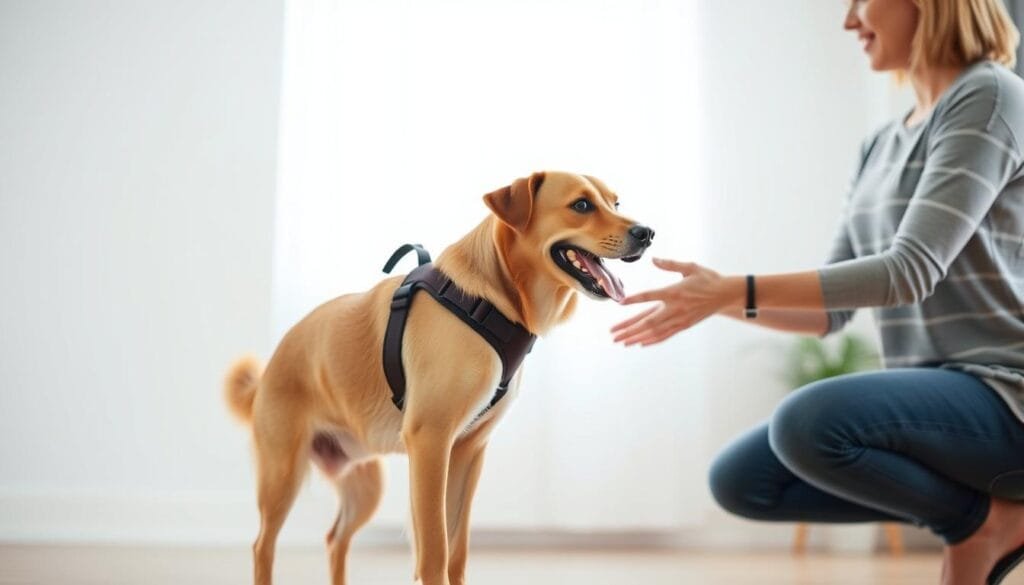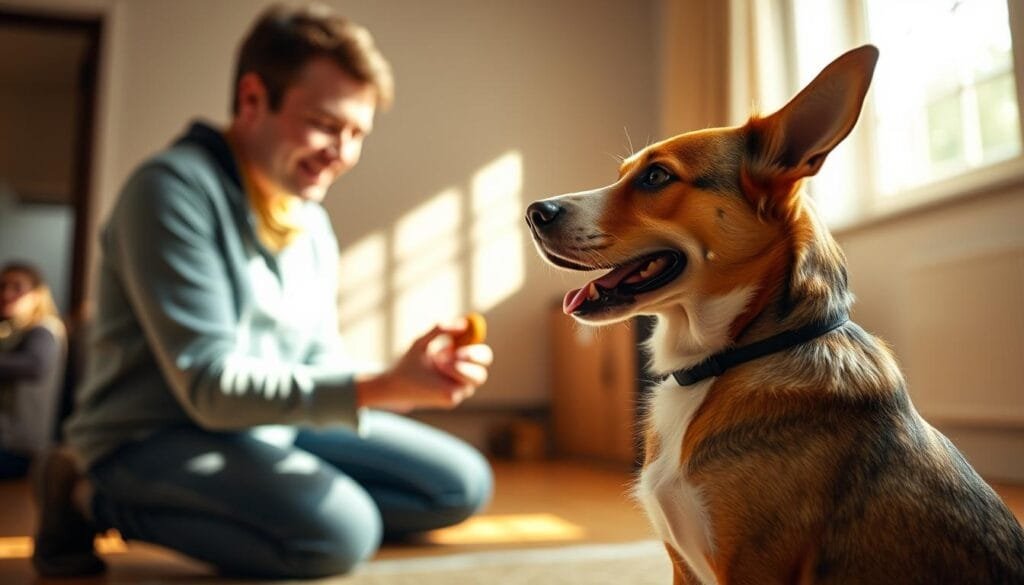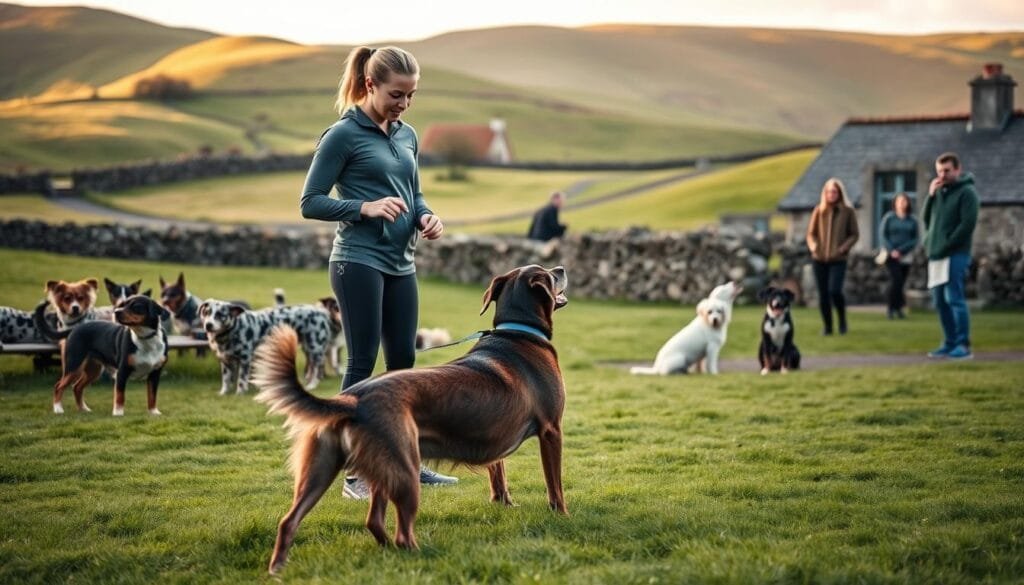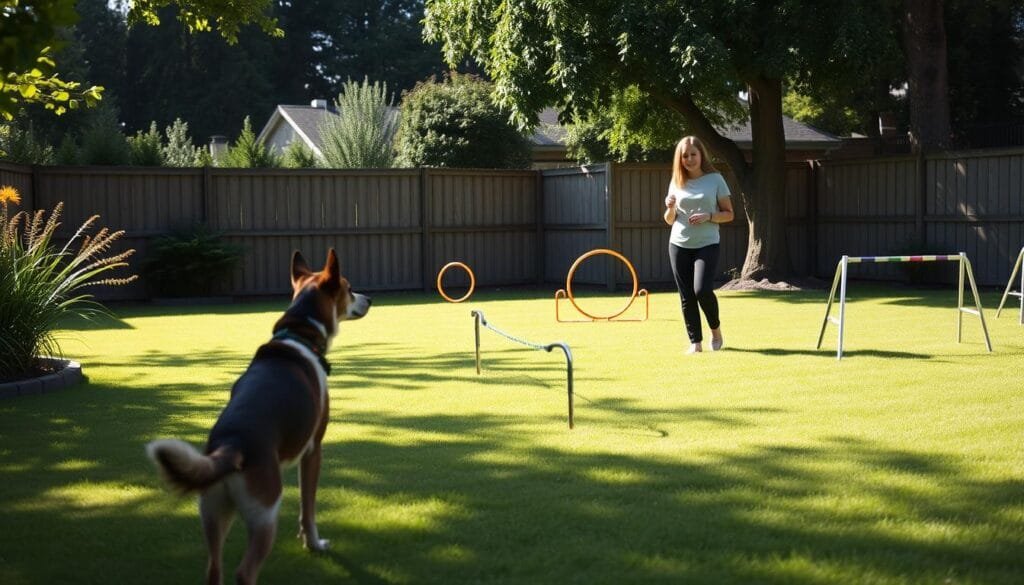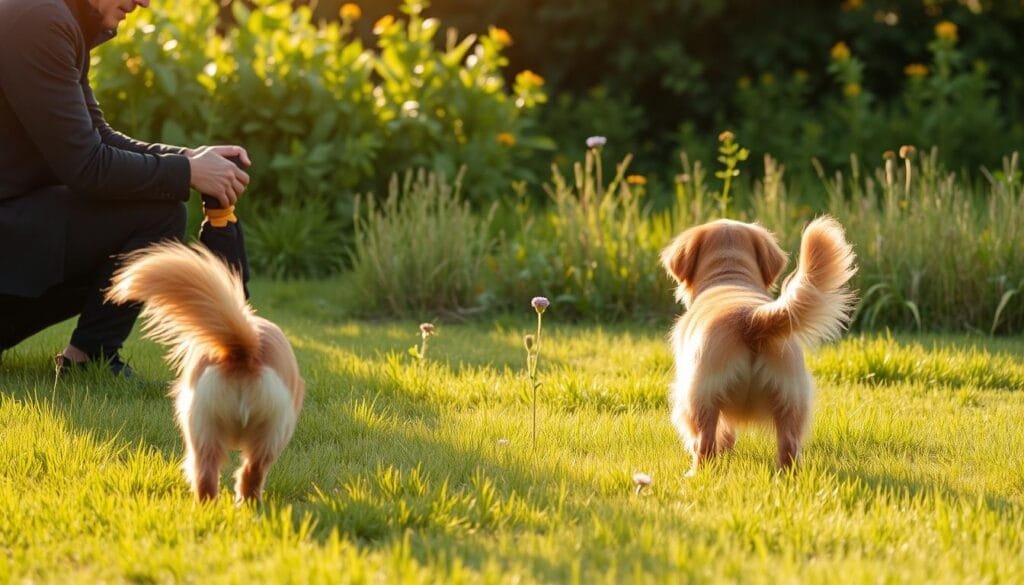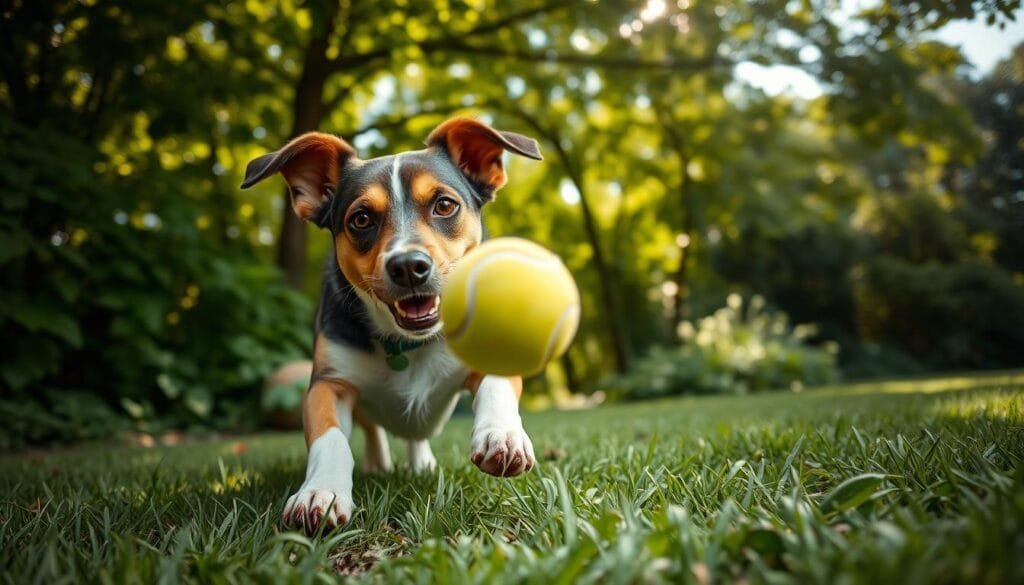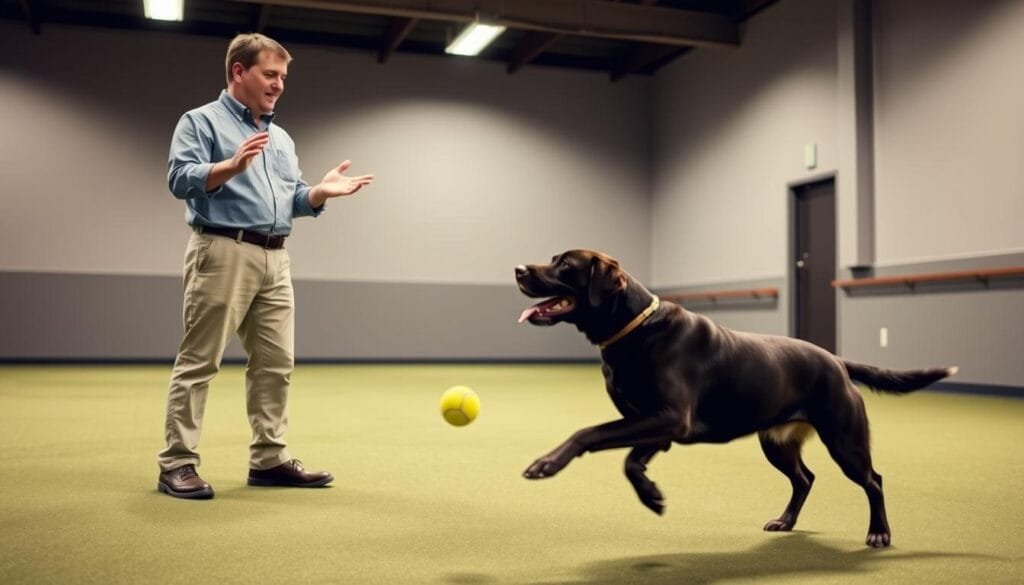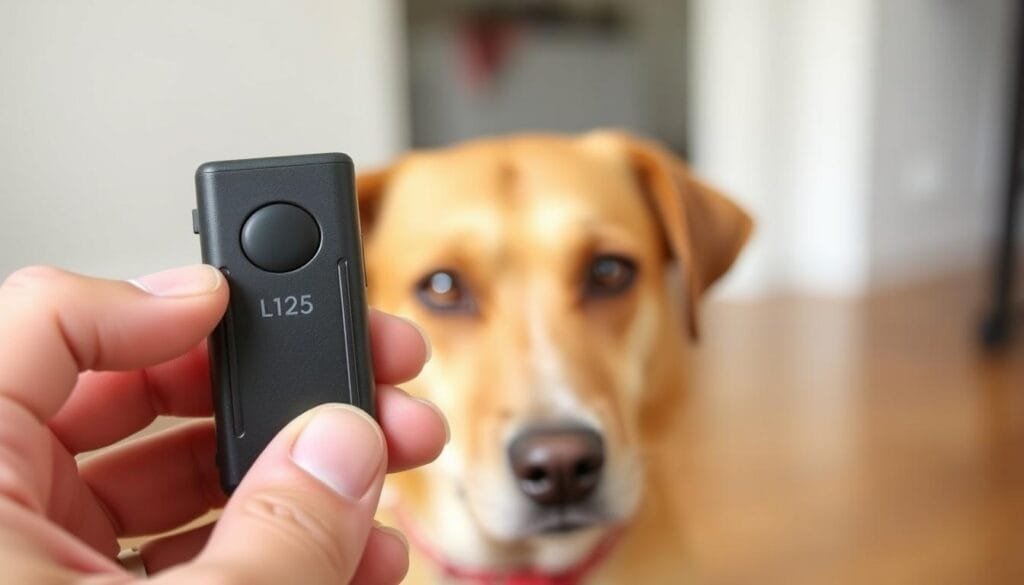Discover Dog Development Stages from Puppy to Adult Dog
Ever thought about how a tiny puppy grows into a confident adult dog? Learning about dog development stages and puppy growth milestones is like finding the secret guide to your pet’s life.
Puppies are amazing, changing a lot as they grow. From birth, they start a journey of growth that shapes their looks and behaviour.
Our dog training skills show that puppy growth is more than just physical changes. It’s about learning, socialising, and growing emotionally. These moments shape your dog’s personality and how they’ll connect with you through the canine developmental phases of their life.
Key Takeaways
- Dog development is a complex, multi-stage process
- Each developmental stage requires unique care and attention as dog age milestones are reached.
- Proper understanding supports healthy puppy growth
- Socialisation periods are crucial for behaviour formation
- Nutritional needs change throughout developmental stages
- Training approaches must adapt to each life stage
Understanding Dog Development Stages
The world of dog growth is full of wonder and change. Each dog has its own special moments that shape who they become. These moments affect their body, mind, and heart.
Puppies go through amazing changes early on. Their growth is a detailed journey of learning and adapting.
Primary Development Phases
Dogs go through several important stages. Each stage has its own unique traits:
- Neonatal Period (0-2 weeks): Complete dependence on mother
- Transitional Period (2-4 weeks): Sensory system development
- Socialisation Period (4-12 weeks): Critical learning window
- Juvenile Period (3-6 months): Rapid physical growth
- Adolescence (6-18 months): Hormonal and behavioural changes
Importance of Growth Monitoring
Keeping an eye on your puppy’s growth is key. It helps spot health issues early. Regular vet visits give you updates on your dog’s growth.
Key Developmental Milestones
Knowing the important moments in a puppy’s life helps with training and care. Puppies go through big changes:
- Eyes open between 10-14 days
- First solid foods introduced around 3 weeks
- Initial socialization begins at 4-6 weeks
- Teething occurs from 12 weeks to 5 months
- Fear periods emerge around 8 weeks and during adolescence
Patience and consistent guidance are essential throughout your dog’s developmental journey.
The Prenatal Period: Development in the Womb
The journey of a dog’s life starts before they take their first breath. The prenatal period is a key time, lasting about 58-68 days in the mother’s womb.
In this time, amazing changes happen that set the stage for a puppy’s health and personality. Here are some important milestones:
- Fertilisation occurs when sperm enters the uterine tube
- Oocytes measure around 230 µm in diameter
- Chromosomal formation completes with 78 total chromosomes
- Embryonic heartbeat first detected between 23-25 days
Maternal health is crucial for puppy development. Studies show that a mother’s diet, stress, and environment affect her puppies.
The quality of maternal care can influence not just current development, but potentially shape future generations through epigenetic changes.
Genetic processes are fascinating during these weeks. Telomeres start forming patterns that could affect a puppy’s long life and health.
Knowing about these stages helps breeders and vets give the best care during this important time.
Neonatal Stage: The First Three Weeks
The neonatal stage is a fascinating time in a dog’s life. It’s when a puppy first experiences the world outside the womb. In these early three weeks, puppies are very vulnerable and rely completely on their mother for survival.
https://www.youtube.com/watch?v=Wf2SoCldmFU
Puppies start their life with many physical and sensory challenges. They sleep a lot, about 90% of their time, which is key for their growth and development.
Physical Development Milestones
- Puppies are born with closed eyes and ears
- Body temperature ranges between 95-99°F at birth
- Weight doubles within the first 10-14 days
- Limited motor skills with minimal movement
Sensory Development
In the neonatal period, a puppy’s world is very limited. Touch and smell are their main ways to interact. Vision and hearing start to develop slowly over the first three weeks.
Mother-Puppy Bonding
The bond between a mother and her puppies is crucial in this stage. Mothers nurse them often, 8-10 times a day. They also keep their puppies warm through close contact.
A puppy’s survival depends entirely on its mother’s care during these critical first weeks.
By the end of the third week, puppies have made a lot of progress. They are ready for the next stage of their growth journey.
Transitional Period: Weeks 3-4
The transitional period is a key time in a puppy’s life. In weeks 3-4, puppies go through big changes. These changes lay the groundwork for their future growth.
This short but important time is when puppies start to explore and move on their own. They begin to see and hear more clearly.
Important things happen during this stage:
- Opening of eyes and ears
- First attempts at walking
- Initial interactions with littermates
- Emerging social behaviours
Puppies start to become more independent. They begin to see and hear more. Visual and auditory capabilities develop rapidly, helping them understand their world better.
Physical and brain changes happen fast. Puppies learn to control their bodies and move better. This is a vital time for their development and learning.
The transition from helpless newborn to curious explorer happens remarkably quickly during these weeks.
It’s important for owners and breeders to create a safe, exciting space. Soft places, quiet sounds, and gentle care help puppies grow well during this time.
Critical Socialisation Period: Weeks 4-12
The critical socialisation period is a key time in a dog’s life, from 4 to 12 weeks and is a huge part of the puppy maturation process. Puppies learn a lot during this time, picking up important social skills. These skills help shape how they behave and interact with others during the following dog life stages
Studies show that this period is crucial for a puppy to grow into a confident adult dog. They learn fast, making it the best time for them to try new things as they move along the dog growth timeline.
Social Skills Development
Important social skills include:
- Interaction with littermates
- Learning communication signals
- Understanding canine body language
- Developing bite inhibition
Environmental Exposure
Exposing puppies to different things helps them become adaptable and confident. They should experience:
- Introducing different sounds
- Encountering various textures
- Meeting diverse people
- Experiencing different environments
Training Foundations
Early training should focus on:
| Training Area | Key Objectives |
|---|---|
| Basic Commands | Sit, stay, come |
| Positive Reinforcement | Reward-based learning |
| Gentle Handling | Build trust and comfort |
Getting professional help during this time can greatly affect a puppy’s future behaviour and emotional health.
Weaning Stage: Introducing Solid Food
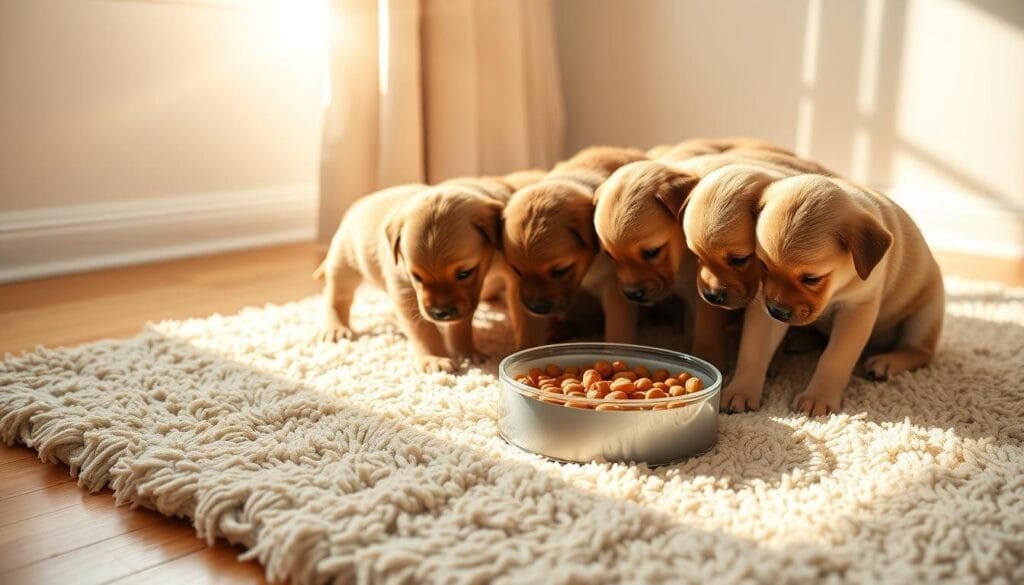
The weaning stage is a key time in a puppy’s life. It’s when they move from drinking their mother’s milk to eating solid food. This is a big step towards becoming independent in their diet.
Weaning starts when puppies are about 3-4 weeks old. It goes on until they are 7-8 weeks old. During this time, they start to eat soft, easy-to-digest foods. It’s a careful process to make sure they get the right food and adapt well.
- Begin introducing softened puppy food around 3-4 weeks
- Mix dry food with warm water to create a porridge-like consistency
- Offer small, frequent meals throughout the day
- Remove uneaten food after 10 minutes
It’s very important to think about what they eat during this time. A good puppy diet should have:
- Protein for muscle growth
- Healthy fats for energy
- Carbohydrates for growth
- Minerals for strong bones
By 5-6 weeks, most puppies eat like adult dogs. But they might still find it hard to eat tough foods. It’s important to be patient and help them get used to eating solid food.
Proper nutrition during weaning sets the foundation for a healthy, thriving dog.
Juvenile Period: 3-6 Months
The juvenile period is a key stage in a dog’s life. It’s when puppies grow fast and change a lot. They go from being young and dependent to becoming more independent and showing their own personalities.
Puppies go through big changes in these months. They grow physically and behaviourally. This is a very important time for training and getting to know other dogs and people.
Physical Growth Milestones
Your puppy will grow a lot during this time. By 6 months, they will have:
- Developed all adult teeth
- Reached about 75% of their adult size
- Had a lot of muscle and bone growth
Behavioural Transformations
Behavioural changes are very noticeable in these months. Puppies start to:
- Be more independent
- Show more curiosity
- Have more complex social interactions
Essential Training Requirements
Training is very important during this time. You should focus on:
- Reinforcing basic obedience commands
- Continuing socialisation
- Establishing consistent routines
- Managing their growing independence
Positive reinforcement is key during this important growth period. It helps shape your puppy’s future behaviour and their relationship with you.
Adolescence: 6-12 Months
Adolescence in dogs is a crucial transitional phase that typically spans from 6 to 12 months of age. This period is characterized by significant physical and behavioral changes as your furry companion moves from the puppy stage into adulthood. During these months, many dog owners notice a surge in energy and a newfound sense of independence.
Just like human teenagers, dogs often become more curious and adventurous, exploring their environments with gusto and sometimes testing boundaries set by their owners. This behavior can be thrilling to witness but may also come with challenges that require patience and understanding.
As dogs navigate their adolescence, they might display some rebellious tendencies. It’s not uncommon for a previously obedient pup to suddenly become disinterested in commands, leading to frustration for pet parents.
This change can be attributed to a variety of factors, including hormonal changes and the drive to establish their social standing among other animals. It’s essential to continue reinforcing training during this time with consistent and positive reinforcement methods, ensuring that good behaviors are encouraged while undesirable ones are gently corrected.
Understanding the broader context of dog aging stages can be beneficial during these pivotal months. Just as humans undergo teenage years, dogs mature differently, and adolescence is an essential part of their developmental timeline.
For instance, small breeds may reach adulthood faster than larger breeds, leading to variations in behaviors and social maturity. It’s important for dog owners to be aware that the adolescent phase will differ across breeds, and adapting your training strategies and expectations accordingly can lead to a more harmonious relationship.
Ultimately, the period of 6 to 12 months is a time of exploration and growth for dogs, and how owners respond to these changes can shape the course of their pets’ lives. Through patience, consistent training, and lots of love, dog owners can help their companions navigate this challenging but exciting stage.
This investment of time and effort not only strengthens the bond between pet and owner but also sets the foundation for a well-adjusted adult dog. Embracing this transformative period can lead to a rewarding relationship that flourishes well into the later stages of a dog’s life.
The adolescent stage in a dog’s life is full of change. Between 6 and 12 months, dogs go through big physical and behaviour changes. These changes can be tough for both the puppy and their owners.
In this phase, puppies go through amazing changes. Small dogs are almost fully grown, while bigger dogs keep growing. They also start to become sexually mature, usually between 6 and 8 months.
- Physical growth rates vary by breed size
- Sexual maturation starts to occur
- Increased energy and independence
- Potential training regression
Adolescent dogs often push boundaries and have lots of energy. It’s like they’re in their teenage years. They might forget old commands and act more rebellious.
Good nutrition and training are very important at this time. Experts say to keep treats under 10% of their daily food. Also, keep training up to help them through this tough time.
Patience and understanding are key to guiding your adolescent dog towards becoming a well-adjusted adult companion.
Fear Period: Understanding and Management
Fear is a natural part of life, not just for humans but for dogs as well. In the context of dog development stages, fear periods are significant phases where puppies become more sensitive to their surroundings and experiences.
Typically occurring between 8 to 12 weeks and again around 6 months, these periods can manifest as heightened anxiety or fearfulness towards new people, sounds, or situations. Understanding these fear periods is crucial for any dog owner who wants to cultivate a confident and well-adjusted pet.
During these fear periods, puppies may exhibit signs of distress, such as cowering, barking, or trying to escape from perceived threats. These reactions can be triggered by anything from loud noises to unfamiliar environments.
It’s essential for owners to recognize these behavioral cues and respond appropriately. For example, comforting a fearful puppy and providing a safe space can help them feel more secure. However, it’s equally important to expose them to new experiences gradually, ensuring that these interactions are positive and not overwhelming.
Management of fear during these developmental stages requires patience and consistency. Positive reinforcement training techniques can help dogs associate new stimuli with rewards and comfort.
Keeping training sessions short and enjoyable, while gradually increasing exposure to challenging situations, can foster resilience. Moreover, engaging with a professional dog trainer can provide tailored strategies that align with the individual dog’s temperament and needs.
Ultimately, navigating through a fear period is part of a dog’s growth and maturation process. With proper understanding and management strategies in place, owners can help their dogs emerge from these phases as more robust and self-assured companions.
Emphasizing socialization and positive experiences is key in this journey, equipping puppies with the tools they need to thrive in an ever-changing world.

Dogs go through important stages as they grow up. The fear period is a tough time when puppies can get very anxious for no reason.
This fear period usually happens between 6 to 18 months old. It makes dogs and their owners feel a lot of emotions. Studies show it can last 2 to 3 weeks, but sometimes it goes on for months.
Common Triggers of Fear Responses
Knowing what scares puppies is key to helping them feel better. Some common things that can scare them include:
- Unfamiliar sounds or places
- Sudden movements
- New people or animals
- Unexpected things to touch
Proper Response Techniques
Helping your dog feel better when they’re scared takes time and the right approach. Experts suggest the following:
- Make scary things seem good
- Don’t force them to face fears
- Try counterconditioning methods
- Stay calm and supportive
| Age Range | Fear Period Characteristics | Recommended Actions |
|---|---|---|
| 6-13 months | Heightened sensitivity | Gentle exposure, positive reinforcement |
| 14-18 months | Potential reactivity | Consistent training, patience |
Knowing that fear periods are a normal part of growing up can help owners deal with these tough times. It’s all about understanding and empathy.
Sexual Maturity Phase
The concept of sexual maturity in dogs is a vital aspect of canine development that owners should understand to ensure their pets thrive. Sexual maturity usually occurs between six months to two years of age, depending on factors like breed and individual development.
During this phase of dog development stages, remarkable changes in behavior and physical attributes can be observed.
For instance, intact males may display increased territorial marking and sometimes more aggressive behavior, while females will experience their first heat cycle, which can provoke their interest in male dogs and lead to specific behavioral changes.
As dogs transition through this phase, it’s essential for owners to recognize the signs of sexual maturity and the challenges that may accompany them. Behavioral issues can escalate if not properly managed; unspayed females may attract male dogs from considerable distances, leading to unwanted mating and subsequent litters.
Similarly, unneutered males may exhibit heightened aggression and a greater propensity for roaming. The need for responsible pet ownership becomes apparent during this stage, with many owners choosing to spay or neuter their dogs to mitigate these behaviors and contribute to the overall health of their pets.
Understanding sexual maturity also goes beyond mere behavioral concerns. It plays a significant role in a dog’s long-term health. Certain health risks, including cancers related to the reproductive system, can be mitigated by spaying or neutering.
Therefore, it is crucial for dog owners to be equipped with knowledge regarding their pets’ reproductive health and to consult veterinarians about the best strategies to manage their dogs during this transformative period.
In summary, the sexual maturity phase is a critical time in a dog’s life that influences their behavior, health, and overall well-being. By being proactive and informed, pet owners can navigate this phase of dog development stages with confidence, ensuring a healthy and balanced life for their beloved companions.
Understanding this vital aspect of dog ownership fosters a deeper connection between humans and their four-legged friends, paving the way for a lifetime of companionship.
The sexual maturity phase is a key time in a dog’s life. Dogs go through big changes in this period, which can last from 6 to 24 months. This depends on the dog’s breed and size.
When puppies reach sexual maturity, they start to go through many changes. Female dogs experience their first heat cycle between 6 to 15 months. They then have heat cycles every 7 months, lasting 2 to 3 weeks each time.
Male dogs also go through changes. They can become fertile as early as 5 months. Their peak fertility is between 12 to 18 months. They may also show changes in behaviour due to testosterone.
Veterinary experts say that physical growth doesn’t mean a dog is ready for breeding. It’s important for dog owners to know about these stages. This helps them make the right choices about breeding and spaying or neutering.
Waiting until a dog is fully mature helps prevent potential health complications and ensures optimal physiological development.
It’s also important to consider the dog’s breed when they reach sexual maturity. Larger breeds may take longer to grow up. Their growth plates usually close between 9 to 11 months.
Training Through Different Life Stages
Dog training changes as your dog grows. Knowing how to adjust your training helps you and your dog stay close.
Training needs to fit each stage of your dog’s life. Between 10 and 17 months, dogs are quieter. This is a great time to teach new skills.
Basic Commands
Teaching basic skills is key early on. Start with commands that help your dog learn more later:
- Sit
- Stay
- Come
- Down
Keep puppy training short, 3-5 minutes. This keeps them interested and avoids getting upset.
Advanced Training
As your dog gets older, teach them harder things. Positive reinforcement keeps them excited to learn.
- Off-leash recall
- Complex verbal commands
- Distraction-proof obedience
Behaviour Modification
Each stage brings its own behaviour challenges. Spotting and fixing these early on stops bigger problems later.
Use consistent training, keep their mind busy, and know their personality and how they learn.
Training is not about perfection, but about building a lifelong connection with your canine companion.
Physical Development Milestones

Knowing your puppy’s growth timeline is key to their care. Each stage has unique physical changes that need attention and support.
Puppies grow fast in their first few months. They change a lot, from tiny newborns to grown dogs.
- Neonatal stage (0-2 weeks): Minimal physical movement
- Transitional stage (2-4 weeks): Beginning of muscle development
- Socialization stage (3-12 weeks): Rapid physical growth
- Juvenile stage (3-6 months): Significant skeletal development
Nutrition is vital for healthy growth. Vets suggest specific diets that change as your puppy grows:
| Age Range | Nutritional Focus | Feeding Frequency |
|---|---|---|
| 0-8 weeks | Mother’s milk/puppy formula | Frequent nursing |
| 8-12 weeks | High-protein puppy food | 3-4 meals daily |
| 3-6 months | Balanced puppy nutrition | 3 meals daily |
Important milestones include teeth coming in at 6-7 months. They reach full height between 12-18 months, based on breed size. Tracking these milestones ensures your puppy grows healthily and gets the right care.
Regular vet visits are crucial. They help monitor growth, address health issues, and guide nutrition at each stage.
Mental and Emotional Growth Patterns
Understanding how dogs develop is key to raising a happy dog. Dogs grow mentally and emotionally in ways that differ by breed and personality.
The journey of a puppy’s growth is full of interesting stages. Studies show that puppies soak up learning and new experiences in their first few months.
- Small breeds typically reach mental maturity by 10-12 months
- Medium breeds mature around 12-15 months
- Large breeds develop mentally by 16-18 months
- Extra-large breeds may take 18-24 months to reach full mental maturation
In the first 3-12 weeks, puppies form key emotional patterns. Gentle handling and positive experiences during this time significantly impact their future temperament and social skills.
| Age Range | Emotional Development Characteristics |
|---|---|
| 0-3 months | Foundational social bonding and sensory exploration |
| 3-6 months | Increased curiosity and initial social interactions |
| 6-12 months | Emerging independence and potential behavioral challenges |
Puppies that face mild, positive stress early on grow more confident and adaptable. This shows how crucial a supportive environment is for a dog’s emotional growth.
Adult Dog Transition: 1-3 Years
The transition to adulthood is a big step for dogs. Most dogs grow into full adults between 1-3 years old. This depends on their breed and how they develop.
Dogs age differently based on their size. Small dogs grow up quicker, reaching adulthood around 9-10 months. Big dogs might take up to 24 months to fully grow up. You’ll see many changes during this time.
- Stabilising energy levels
- More predictable behaviour patterns
- Enhanced focus and trainability
- Physical maturation completion
Vets have some advice for this stage:
- Annual health check-ups become crucial
- Transition to adult dog nutrition
- Adjust exercise routines
- Continue consistent training
Nutrition is key during these stages. Dogs usually switch to adult food around one year. Bigger dogs might need puppy food until 18-24 months. It’s important to keep their weight in check and feed them right.
As dogs grow, their behaviour changes too. They become more consistent and understand their home better. This is a great time to keep training and get closer to your dog.
Conclusion
Our look into dog development stages shows how a puppy grows from a vulnerable newborn to a mature adult. Each stage has its own challenges and amazing changes. These changes shape a dog’s body and mind.
Watching a puppy grow means spotting important milestones in their senses, body, and behaviour. Puppies start off needing their mother a lot. Then, they grow more independent as they get older. This journey includes fast weight gain, learning new senses, and important times for socialising.
Getting help from experts is key during these stages. Malcolm from Activk9s dog training suggests plans that fit each dog’s own pace. For help and advice on your puppy’s growth, call Malcolm at 089-4120124. This way, you can give your dog the best care as they grow.
Being patient, consistent in training, and watching your dog closely is crucial. By understanding dog development, you can create a strong bond with your pet. This bond lasts a lifetime.
FAQ
At what age do puppies start to socialise?
Puppies start to socialise from weeks 4-12. This is when they are most open to new things. It’s the best time to introduce them to people, animals, and places.
How long does the weaning process typically last?
Weaning is when puppies switch from milk to solid food. It starts around 3-4 weeks and finishes by 7-8 weeks. The exact time depends on the puppy and its breed.
What is the fear period in a dog’s development?
The fear period is a key time when puppies may become anxious or fearful. It happens early in their life. They need patience and positive encouragement to feel confident.
When do dogs reach sexual maturity?
Dogs reach sexual maturity between 6-24 months. This depends on the breed. They go through physical and behaviour changes, like heat cycles in females and marking in males.
How long does the juvenile period last?
The juvenile period is from 3 to 6 months. It’s a time of fast growth and learning. Puppies develop adult teeth and become more independent during this stage.
What are the most important stages of puppy development?
Key stages include the neonatal period (0-3 weeks), transitional period (3-4 weeks), and critical socialisation period (4-12 weeks). The juvenile period (3-6 months) and adolescence (6-12 months) are also crucial. Each stage is vital for a puppy’s growth.
How can I support my puppy’s development?
Support your puppy with consistent training and positive socialisation. Provide good nutrition, regular vet visits, and lots of mental and physical activities. Adjust your approach based on each developmental stage.
When do puppies open their eyes and ears?
In the neonatal stage, puppies start to develop their senses. Their eyes open around 10-14 days. Their ears start working soon after, helping them understand their surroundings.
How long does the adolescence stage last?
Adolescence in dogs is from 6-12 months. It varies by breed. During this time, dogs go through hormonal changes, become more independent, and may test boundaries.
What is the transition to adulthood like for dogs?
Dogs become adults between 1-3 years, depending on the breed. This stage is marked by settled behaviour, physical maturity, and a consistent personality and energy level.
Source Links
- Puppy’s development – from puppy to adult dog – Bozita International – https://bozita.com/life-with-your-dog/your-dogs-development/puppys-development-from-puppy-to-adult-dog/
- Puppy Developmental Stages: From Birth to Adulthood (Vet Reviewed) – Dogster – https://www.dogster.com/dog-health-care/stages-of-puppy-development
- Puppy Development Stages & Behaviour Into Adulthood | Eukanuba | Eukanuba – https://www.eukanuba.com/au/puppy/puppy-articles/puppy-development-stages-and-behaviour-into-adulthood
- Puppy Development Stages From Birth to 2 Years Old – https://bestfriends.org/pet-care-resources/puppy-development-stages-birth-2-years-old
- Puppy development stages: A guide – https://zigzag.dog/en-us/blog/puppy-training/training-basics/puppy-development-stages-from-birth-to-adulthood/
- Prenatal Development – https://veteriankey.com/prenatal-development/
- No title found – https://www.akc.org/expert-advice/dog-breeding/start-even-younger/
- Your Dog’s Pregnancy Week by Week – Baldivis Vet Hospital – https://www.baldivisvet.com.au/your-dogs-pregnancy-week-by-week/
- Puppy Care Stages: Newborn to 48 Weeks – https://www.care.com/c/en-ie/puppy-care-stages-newborn-to-48-weeks/
- New Puppy Care: 0-7 Weeks – https://www.petmd.com/dog/care/new-puppy-care-0-7-weeks
- Developmental Puppy Phases – Chance 2 Ranch – https://www.chance2ranch.com/developmental-puppy-phases/
- Guide to puppy development stages – ReadyDog – https://readydog.co/guide-to-puppy-development-stages/
- Puppy Development and socialisation – https://murphyandme.ie/blogs/news/puppy-devlopment
- Puppy Developmental Stages and Behaviour – Regina Humane Society Inc – https://reginahumanesociety.ca/programs-services/alternatives-to-admission/dog-behaviour-tips/puppy-developmental-stages-and-behaviour/
- Dog Developmental Stages Explained – Freak on a Leash – https://freakonaleashdogtraining.com/dog-developmental-stages-explained/
- Feeding puppies from birth to weaning – https://www.thekennelclub.org.uk/health-and-dog-care/health/health-and-care/a-z-of-health-and-care-issues/feeding-your-puppy-from-birth-to-weaning/
- When Can Puppies Eat Solid Food? What To Know about Weaning Puppies – https://www.petmd.com/dog/nutrition/when-can-puppies-eat-solid-food
- Puppy Developmental Stages (Timeline) | Pooch & Mutt – https://www.poochandmutt.co.uk/blogs/puppy/developmental-stages?srsltid=AfmBOooPU7AlzcgBBth-qTSAQSeq4AumXSKUoBxuz9lPWzjZw1NOzydQ
- Caring for Your Puppy From Ages 3 to 6 Months – https://www.thesprucepets.com/puppies-three-to-six-months-4570930
- Puppy Development From 6 Months to 1 Year – https://www.thesprucepets.com/stages-of-puppy-development-2804675
- No title found – https://www.akc.org/expert-advice/puppy-information/puppy-growth-timeline-transitions-puppyhood/
- Adolescent Fear Periods in Dogs – ELLAS Animals INC – https://ellasanimals.org/uncategorized/adolescent-fear-periods-in-dogs/
- Different Stages Of Puppy Development & Fear Periods | See Spot Learn – https://www.seespotlearn.co.nz/different-stages-of-puppy-development-fear-periods/
- No title found – https://www.akc.org/expert-advice/health/sexual-maturity-in-puppies-what-to-expect/
- Dog Puberty: What You Need to Know | Purina – https://www.purina.co.uk/articles/dogs/puppy/health/dog-puberty
- Puppy Development Stages and Dog Life Cycle – https://animalhotels.com/gb/blog/dogs/puppy-development-stages-and-dog-life-cycle
- The Importance of Training Dogs at Every Life Stage | Bond Vet – https://bondvet.com/b/the-importance-of-training-dogs-at-every-life-stage
- Dog Training for Different Stages of Life – https://petstek.com/blogs/petstek-blog/dog-training-for-different-stages-of-life?srsltid=AfmBOoohrAvqijPUCOY6IT9w_I1q5EsZJdu4AcpyadILeW5oiD13_pLw
- The Developmental Stages of a Puppy: What to Expect Month by Month | Caring Hearts Animal Hospital – https://caringheartsanimalhospital.com/blog/puppy-developmental-stages/
- The Puppy Timeline: Physical And Mental Changes – https://vetmed.tamu.edu/news/pet-talk/puppy-timeline-part-1/
- An overview of canine development | Dogs Trust – https://www.dogstrust.org.uk/how-we-help/professionals/vet-clinics/resources/canine-behavioural-development
- When Are Dogs Adults? When Do Puppies Mature Mentally? | Pupford – https://pupford.com/blogs/all/when-dogs-reach-mental-maturity?srsltid=AfmBOooI8SuhHOQTfMkggZ8Fsvp9RPDIEj3lk0C-6PKcl_m_xbdlTUY8
- Life Stages of a Dog | ASPCA Pet Health Insurance – https://www.aspcapetinsurance.com/resources/stages-of-a-dogs-life/
- Puppy to Dog: Your Pet’s Life Stages – https://www.webmd.com/pets/dogs/life-stages
- Dog maturity: When does a puppy become a dog? | Barc London – https://www.barclondon.com/blogs/dog-training-behaviour/when-does-puppy-become-dog?srsltid=AfmBOorvHkoK4smMdrn1iVd5kTX8zlm7lVGZejNQGeWupD6AhIB6jATl
- When Does Your Puppy Become an Adult Dog? – https://thevets.com/blog/when-is-a-puppy-considered-an-adult-dog/
- Dog Puppy Development | Timeline and Stages | Seleverkstedet® – https://www.seleverkstedet.com/se/en/valpens-utvikling
- Puppy Love: The Critical Stages Of Puppy Development – https://dog-house.ae/dogs-physical-health/stages-of-puppy-development/
- Puppy Development Week By Week – A Guide To The Important Stages – https://www.thelabradorsite.com/puppy-development/
